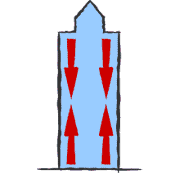PBS.ORG. WEBSITE.
1. The relationship between skyscrapers and gothic cathedrals
- The term “skyscraper” was coined in the 1880s, shortly after the first tall buildings were constructed in the United States — but the history of tall buildings dates back hundreds of years. Since the Middle Ages, engineers have engaged in a battle for the sky.
- Before there were skyscrapers, there were towers. Made of heavy stone, towers had thick, sturdy walls, but the rooms were dark and cramped — too many windows would have weakened the structure.
- Soon Gothic cathedrals joined the quest for height. Long, stone arms, called flying buttresses, supported the cathedral’s heavy weight, allowing the walls to be filled with colorful glassWith steel came the first modern skyscrapers. During the Industrial Revolution, engineers began experimenting with two new materials — iron and steel. The 10-story Home Insurance Building in Chicago was the first tall building to be supported by a steel skeleton of vertical columns and horizontal beams. But even with windows, the closely spaced columns and deep beams made rooms in the Home Insurance Building feel tight windows.
- With steel came the first modern skyscrapers. During the Industrial Revolution, engineers began experimenting with two new materials — iron and steel. The 10-story Home Insurance Building in Chicago was the first tall building to be supported by a steel skeleton of vertical columns and horizontal beams. But even with windows, the closely spaced columns and deep beams made rooms in the Home Insurance Building feel tight and cramped.
- Who wants to climb all those stairs? In 1857, the installation of the first passenger elevator in the Haughwout Department Store in New York City made it possible and practical to construct buildings more than four or five stories tall.
- New structural designs made skyscrapers even lighter and stiffer. As skyscrapers grew taller and taller, engineers were faced with a new enemy: wind. Today’s tallest skyscrapers, which are almost 1,500 feet tall, must be 50 times stronger against wind than the typical 200-foot buildings of the 1940s.
- How do engineers design skyscrapers to resist wind?
- By clustering steel columns and beams in the skyscraper’s core, engineers create a stiff backbone that can resist tremendous wind forces. The inner core is used as an elevator shaft, and the design allows lots of open space on each floor.
- In newer skyscrapers, like the Sears Tower in Chicago, engineers moved the columns and beams from the core to the perimeter, creating a hollow, rigid tube as strong as the core design, but weighing much, much less.
But when the wind blows, the columns on the windy side stretch apart, and the columns on the other side squeeze together.
I would like to introduce a video named Building the Great Cathedrals that Take a dazzling architectural journey inside those majestic marvels of Gothic architecture, the great cathedrals of Chartres, Beauvais and other European cities. Carved from 100 million pounds of stone, some cathedrals now teeter on the brink of catastrophic collapse. To save them, a team of engineers, architects, art historians, and computer scientists searches the naves, bays, and bell-towers for clues. NOVA investigates the architectural secrets that the cathedral builders used to erect their towering, glass-filled walls and reveals the hidden formulas drawn from the Bible that drove medieval builders ever upward.
the video tag: http://www.pbs.org/wgbh/nova/ancient/building-gothic-cathedrals.html
2. JOHN D ROCKEFFELLER WHO BUILT NEW YORK BASED ON HIS OIL MONOPOLY
John D. Rockefeller was the world’s first billionaire and the most hated man in America. John Davison Rockefeller (July 8, 1839 – May 23, 1937) was an American industrialist and philanthropist. He was the founder of the Standard Oil Company, which dominated the oil industry and was the first great U.S. business trust. Rockefeller revolutionized the petroleum industry and defined the structure of modern philanthropy. In 1870, he founded the Standard Oil Company and aggressively ran it until he officially retired in 1897.
Rockefeller Center was named after John D. Rockefeller, Jr., who leased the space from Columbia University in 1928 and developed it from 1930. Rockefeller initially planned a syndicate to build an opera house for the Metropolitan Opera on the site, but changed his mind after the stock market crash of 1929 and the Metropolitan’s continual delays to hold out for a more favorable lease, causing Rockefeller to move forward without them. Rockefeller stated “It was clear that there were only two courses open to me. One was to abandon the entire development. The other to go forward with it in the definite knowledge that I myself would have to build it and finance it alone.”He took on the enormous project as the sole financier, on a 27-year lease[(with the option for three 21-year renewals for a total of 87 years) for the site from Columbia; negotiating a line of credit with the Metropolitan Life Insurance Company and covering ongoing expenses through the sale of oil company stock. The initial cost of acquiring the space, razing some of the existing buildings and constructing new buildings was estimated at $250,000,000 dollars.It was the largest private building project ever undertaken in modern times.Construction of the 14 buildings in the Art Deco style (without the original opera house proposal) began on May 17, 1930, and was completed in 1939. Principal builder and “managing agent” for the massive project was John R. Todd. Principal architect was Raymond Hood, working with and leading three architectural firms on a team that included a young Wallace Harrison, later to become the family’s principal architect and adviser to Nelson Rockefeller. The construction of the project employed over 40,000 people.
VIDEO TAG:http://video.pbs.org/video/2311494786





